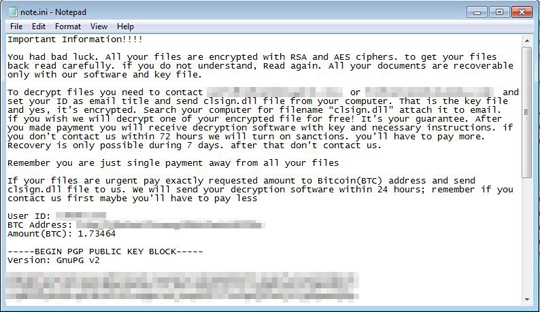RANSOM_CRYPFUN.A
Luhe.Fiha.P (AVG), Ransom.FileCryptor (Malwarebytes), Ransom:Win32/FileCryptor (Microsoft)
Windows


Threat Type: Trojan
Destructiveness: No
Encrypted: No
In the wild: Yes
OVERVIEW
This Trojan arrives on a system as a file dropped by other malware or as a file downloaded unknowingly by users when visiting malicious sites.
TECHNICAL DETAILS
Arrival Details
This Trojan arrives on a system as a file dropped by other malware or as a file downloaded unknowingly by users when visiting malicious sites.
Dropping Routine
This Trojan drops the following files:
- {malware path}\trc.dll - list of files which extension is not for encryption and not for avoidance
- {malware path}\rar.exe - WinRAR executable version 3.64
- {malware path}\clsign.dll - Crypto key file
- {hard drive letter}\clsign.dll
- {malware path}\note.ini - Ransom note
- {malware path}\wallet.jpg - QR code
Other Details
This Trojan connects to the following URL(s) to get the affected system's IP address:
- http://whatismyip.net
It encrypts files with the following extensions:
- .txt
- .xls
- .xlsx
- .doc
- .docx
- .rtf
- .ppt
- .pptx
- .pps
- .gpg
- .pgp
- .c
- .cpp
- .asm
- .cs
- .php
- .pas
- .class
- .py
- .pl
- .h
- .vb
- .vcproj
- .vbproj
- .java
- .bak
- .backup
- .mdb
- .accdb
- .mdf
- .odb
- .wdb
- .csv
- .tsv
- .sql
- .psd
- .eps
- .cdr
- .cpt
- .indd
- .dwg
- .ai
- .svg
- .max
- .skp
- .scad
- .cad
- .3ds
- .blend
- .lwo
- .lws
- .mb
- .db
- .pptm
- .pptx
- .xlsb
- .xlsm
- .docm
- .key
- .asp
- .tif
- .vbs
- .epub
- .mobi
- .one
- .zip
- .rar
- .htm
- .aes
It renames encrypted files using the following names:
- {Original filename and extension}.cry
It does the following:
- It avoids files with the following extensions:
- .cry
- .exe
- .dll
- .sys
- .com
- .cpl
- .theme
- .ttf
- .chm
- .bat
- .cmd
- .gif
- .ico
- .lnk
- .manifest
- .msi
- .scr
- .tmp
- .url
- .inf
- .ini
- .torrent
- .avi
- .mp3
- .flv
- .mkv
- .mov
- .asf
- .mpeg
- .vob
- .mpg
- .gif
- .raw
- .srt
- .sub
- .3GP
- .DIVX
- .WMV
- .rm
- .m4v
- .ocx
- .tmp
- .Manifest
- .log
- .ttf
- .fon
- .hlp
- .chm
- .chi
- .reg
- .url
- .nfo
- It uses WinRAR.exe to encrypt the files using the following command:
- "{malware path}\rar.exe" a -m1 -df -dh -idcdpq -ep -hp{password} "{Original filename and extension}.cry" "{Original filename and extension}"
- The parameters meaning the following:
- a - add files to archive
- m1 - compression level 1
- df - delete files after archiving
- dh - open shared files
- idcdpq - disable messages
- hp{password} - encrypt both file data and headers
- It drops the following ransom note:

SOLUTION
Step 1
Before doing any scans, Windows XP, Windows Vista, and Windows 7 users must disable System Restore to allow full scanning of their computers.
Step 2
Note that not all files, folders, and registry keys and entries are installed on your computer during this malware's/spyware's/grayware's execution. This may be due to incomplete installation or other operating system conditions. If you do not find the same files/folders/registry information, please proceed to the next step.
Step 3
Search and delete this file
- {malware path}\trc.dll
- {malware path}\rar.exe
- {malware path}\clsign.dll
- {hard drive letter}\clsign.dll
- {malware path}\note.ini
- {malware path}\wallet.jpg
Step 4
Scan your computer with your Trend Micro product to delete files detected as RANSOM_CRYPFUN.A. If the detected files have already been cleaned, deleted, or quarantined by your Trend Micro product, no further step is required. You may opt to simply delete the quarantined files. Please check this Knowledge Base page for more information.
Step 5
Restore encrypted files from backup.
Did this description help? Tell us how we did.

